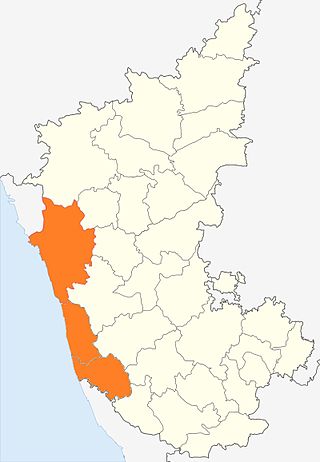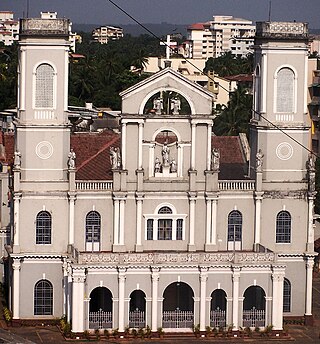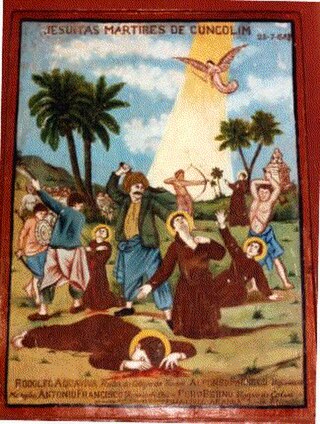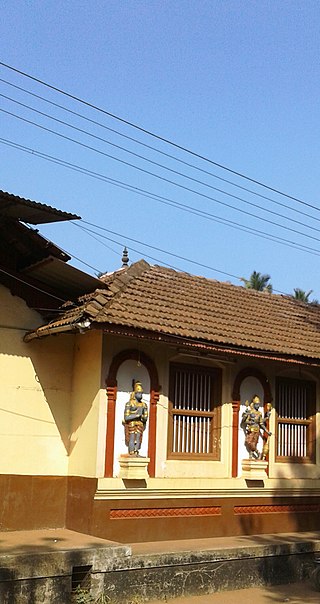Padval is a subgroup of the Christian Cxatria caste, [1] bearing the same paik surname [2] among Mangalorean Catholics, they converted from the Jain Bunt varna that is native to Canara in Karnataka. [ citation needed ]
A large number of Goan Catholics immigrated to Canara in the 16th and 17th centuries due to various causes. [3] [4] Padvals were the local Catholic converts of South Canara and did not mix with these Christian immigrants from Goa. In The Marriage Customs of the Christians in South Canara, India (1965), Severine Silva speculated that the Padvals in the Christian community were converts from Jainism. [1]
According to Mangalorean genealogist Michael Lobo, the major Padval clans are the Rodrigues family of Ambepol, Bantwal, Bejai, Nod and Kadri; Tauro family of Bantwal, Kodialbail and Kankanadi; Lobo family of Bellore, Derebail and Mermajal; and D'Souza family of Bejai, Kadri and Vamanjoor. [5]

Kanara or Canara, also known as Karāvali, is the historically significant stretch of land situated by the southwestern Konkan coast of India, alongside the Arabian Sea in the present-day Indian state of Karnataka. The subregion comprises three civil districts, namely: Uttara Kannada, Udupi, and Dakshina Kannada. Kasaragod was included prior to the States Reorganisation Act.

Mangalorean Catholics are an ethno-religious community of Latin Christians from the Diocese of Mangalore and the erstwhile South Canara area, by the southwestern coast of present-day Karnataka, India.

The Milagres Church is a historic Roman Catholic Church situated in the Hampankatta locality of Mangalore. The church was built in 1680 by Bishop Thomas de Castro, a Theatine from Divar, Goa. The original structure was constructed at the site of the present-day cemetery. It is one of the oldest churches in Dakshina Kannada.
Mangalore district that was partitioned from the erstwhile South Canara, has been multicultural and is a little different from the prevalent culture of the Carnataca state of India. A native of Mangalore is known as a Mangalorean in English, Kudladakulu in Tulu, Kodyaalkar in Konknni, Manglurnavaru in Kannada& Maikaaltanga in Byari.
Roman Catholic Brahmin is a Christianised caste among the Goan, Bombay East Indian & Mangalorean Catholics; who are patrilineal descendants of Konkani Brahmin and Daivajna converts to the Latin Church. This occurred parts of the Konkan region that were annexed into the Portuguese East Indies, with the capital (metropole) at Velha Goa & Bombay was the largest territory (province) of Portuguese India. They retain some of the ethno-social values and customs of their ancestors, and most of them exhibit a noticeable hybrid Latino-Concanic culture.
The culture of Mangalorean Catholics has been shaped by their Christianisation in Goa, their migrations& their captivity. They adopted elements of the local Mangalorean culture, but retained many of their Konkani customs and values. The ethnic Mangalorean houses of the older generation have spacious porticos, red oxide cemented floors, terra cotta roofs layered with the once famous Mangalore tiles. The houses are usually accompanied by their own private wells or ponds, and are normally attached to orchards of coconut trees, jackfruit trees, ice apple trees, Alphonso mango trees, areca nut trees etc.
The History of Mangalorean Catholics begins with the legacy of Lusitanian culture, from the conversion of their Konkani ancestors to Roman Catholicism in the colonies of the Portuguese in Goa and Bombay, followed by the migration of the Roman Catholics in Goa to Mangalore and other parts of South Canara between the mid-16th and mid-18th centuries, forming a unique Mangalorean Catholic identity, and the subsequent growth and development of the community. Four centuries of living in South Canara gave these Catholics an identity of their own, distinct from Goans and Bombay East Indians.
Mangalorean Catholic names and surnames encompass the different naming conventions of the Mangalorean Catholic community. Historically, many of them had names of Christian saints, while Portuguese-language surnames were most commonly found. A formal Mangalorean Catholic name consists of a given name, a middle name, and a surname.
History of Goan Catholics recounts the history of the Goan Catholic community of the Indian state of Goa from their conversion to Christianity to date.
Mangaloreans are a collection of diverse ethnic groups that hail from the historical locales of South Canara (Tulunaad) on the south western coast of Karnataka, India, particularly the residents native to Mangaluru.
The Captivity of Mangalorean Catholics at Seringapatam (1784–1799) was a 15-year-long imprisonment of Mangalorean Catholics and other Christians at Seringapatam, in the Carnataca region of India by Tippu Sultan; who was the de facto ruler of the Kingdom of Mysore following its usurpation. Estimates of the number of captives range from 30,000 to 80,000, but the generally accepted figure is 60,000, as stated by Tippu himself in the Sultan-ul-Tawarikh. The captivity was the most disconsolate period in the community's history.

Church of Our Lady of Rosary of Mangalore, or Rosario Cathedral is a Roman Catholic cathedral in the Roman Catholic Diocese of Mangalore, dedicated to Our Lady of the Rosary. It was the first Roman Catholic church in the Canara region.
Pius Fidelis Pinto is an Indian priest and research scholar of Christianity in Canara, India. He is noted for his research work and publications on the history of Konkani Christians of Dakshina Kannada then erstwhile South Canara. He has written eight books and presented 36 research papers at various events across the world.
Mudartha is a family name and title held by some Mangalorean Catholic Bamonn clans hailing from Udupi district in Karnataka.
Participation of Mangalorean Catholics in the Indian Independence Movement recounts the community's role in the Indian Independence Movement.

Roman Catholic Kshatriyas or Christian Kshatriyas are a modern Christianised caste among Goan, Bombay East Indian, Mangalorean, Kudali & Karwari Catholics. They are patrilineal descendants of Kshatriya and Vaishya Vani converts to the Latin Church, in parts of the Konkan region that were under Portuguese Goan rule. They are known as Chardo in Goan Konkani, Charodi in Canarese Konkani & as Sandori or Vadval in Damanese-Maharashtrian Konkani; while others identify as Khatri, Panchkalshi & Pathare in their Bombay East Indian dialects. Some Chardos have maintained endogamy, while others have intermarried with Bamonns.
Attire of Mangalorean Catholics refers to the traditional clothing of the Mangalorean Catholics from the Mangalore Diocese on the southwestern coast of India.

Bantwal taluk is a taluk of Dakshina Kannada district. The headquarters is the town of Bantwal, an eastern suburb of Mangalore.
Dom Thomas de Castro (c.1621-1684) was a native of Divar in Goa, Portuguese India. The Holy See appointed him Vicar Apostolic of Canara on 30 August 1675. He later founded the famous Milagres Church in Mangalore, South Canara, Karnataka. He was the nephew of Dom Matheus de Castro (c.1594−1677), the first Indian Bishop of The Catholic Church.

Aloysius Paul D'Souza is the former Bishop of the Roman Catholic Diocese of Mangalore. He was consecrated on 8 November 1996, succeeding his predecessor Basil Salvadore D'Souza.
{{cite journal}}: Cite journal requires |journal= (help)